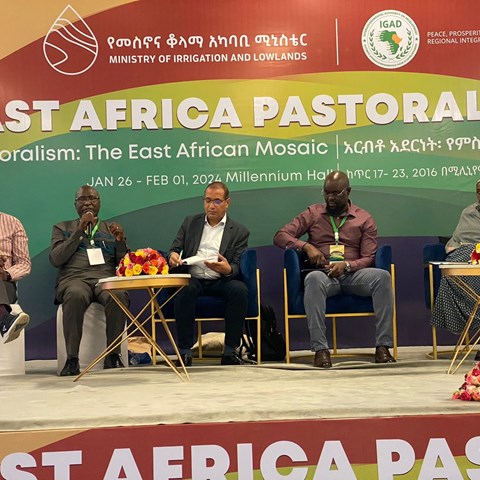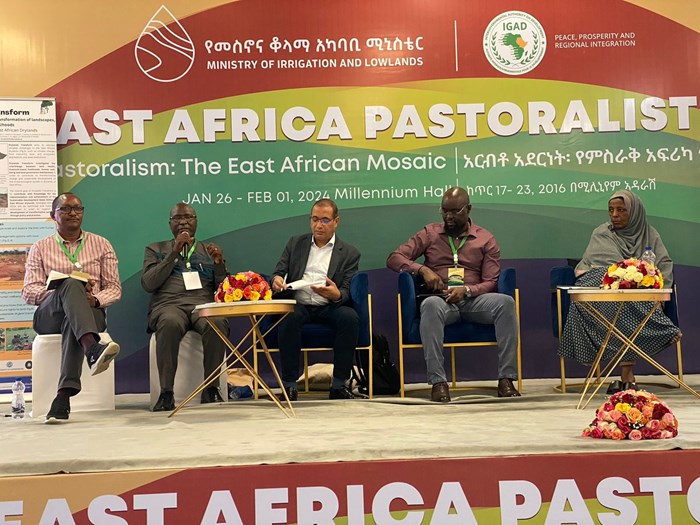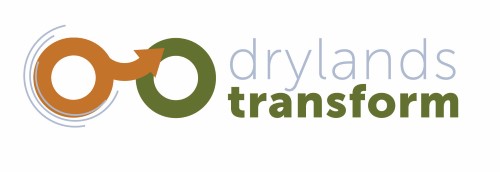The panel discussion was opened by a brief from Ms Sadia Muse Ahmed of PENHA who highlighted on the need for government policy framework to entrench, guide and fund ecosystem restoration. She noted that many conferences, workshops and projects have been held aimed at addressing the issues affecting pastoralists, but todate, no significant step has been taken to address the problem of “moving pastoralists”.
Sadia further highlighted that technologies for restoration of rangelands ecosytems are known, the role of trees and land health are known, the role of livestock in national economies and household livelihoods are known and the effects of climate change on the rangelands have been researched, but the problem of the moving pastoralists has not been settled. She saw that part of the problem was lack of deliberate support for rangeland restoration efforts from IGAD member state governments. She challenged governments to budget for restoration activities and create multi-stakeholder engagements for supporting and promoting rangeland restoration technologies. She encouraged governments to emulate the Ethiopian Government that has a National Drylands Restoration Strategy.
Dr. Stephen Mureithi of the University of Nairobi and the Kenya Country Coordinator for Drylands Transform, noted that drylands degradation can be reversed through restoration, recreating more resilient and productive land that will fix more carbon especially in the soil, restore ecosystem services, promote new and viable enterprises and create employment especially for the youth and women while reducing conflicts and migration. He added that restoration is really a triple win for the SDGs, and targets for the Rio Conventions - Desertification, Climate Change, and Biodiversity. He noted that there is a growing momentum in the national commitments for drylands restoration within the Bonn Challenge among other, but we need to change the approach and concerted efforts with the scarce financial resources so that we can be effective and have pragmatic outcomes. On the question of how we can achieve scaling-out and pastoralists’ adoption of interventions for restoration of the drylands, Dr. Mureithi added a few points:
- We need to improve our understanding of restoration successes, document and disseminate proven approaches, significant outcomes and lessons learnt.
- Sustaining restoration and achieving scale is only possible when the community members in catchments and landscapes are involved through owning the challenge and they decide to invest in relatively low-cost restoration actions, which already produce short-term economic and environmental benefits.
- Community engagements takes time and layering and sequencing of drylands restoration projects and programmes is crucial, to avoid the engage-disengage scenarios where a lot of resources are wasted with on pragmatic outcomes. Here, the governments need to take a lead role, in coming up with a plan for the county/district/region or country, and engage developmental stakeholders towards the achievement of that plan. Community partition at the planning and implementation stages is crucial.
- Continued capacity building, from land preparation, growing periods, harvesting, value addition and marketing is needed in the restoration business models that will them drive the restoration efforts by community groups and individuals.
Professor Denis Mpairwe of Makerere University and the Uganda Country Coordinator for Drylands Transform, emphasised on the need to come to the level of the people, the communities and train them on technologies through the experiential learning approach. Prof. Mpairwe highlighted the following as the successful models within the region that can be replicated for rangeland restoration in the drylands of East Africa:
- He noted that through "Livestock cafés"/knowledge sharing hubs, Drylands Transform is testing options to restore rangelands under grazing by engaging local communities. Different technologies for harvesting water, reseeding with rangeland grasses and forage legumes, regenerative kitchen gardening and value addition are demonstrated and the communities can choose which ones to adopt. Kitchen gardening is now picking up as a common practice in the Karamoja cluster region and there is need for supporting this intervention in other drylands in the region.
- The contribution of various pasture restoration techniques in enhancing livestock water productivity on degraded bare surfaces which was conducted in Nakasongola drylands of Uganda by Mugerwa et al 2012.
- The use of enclosures as a land management tool for food security in the drylands. and in transforming land, livestock and livelihoods in drylands of West Pokot, Kenya. Enclosures transformation was associated with land rehabilitation, fodder production, and land and livestock management.
- Fodder reserves and storage for use in times of severe shortage practiced in Zimbabwe could be adopted in the East African drylands.
Responding to the question of how to attract more stakeholder support in restoration initiatives, Mr. Molla Derajo of the Ministry of Irrigation and Lowlands (MILLs) in Ethiopia noted that stakeholder support and involvement in the drylands livelihoods resilience projects is important. He gave examples of integrated livelihoods such as fodder and multipurpose trees, apiculture, aquaculture, and livestock finishing that can be supported from the restoration of the degraded drylands. He also added that it’s important to align the restoration effort with national development goals, include business models for scaling climate resilience. Finally, he emphasised on the need for collaboration and networking and dissemination within the region to exchange knowledge.
Dr. Ahmed R. Elbeltagy of AU-IBAR added, while discussing how to convince member state governments and development partners to allocate budgets and prioritise funding towards restoring the drylands, that sustainable dryland restoration is highly needed, and there is need to focus on evidence-based interventions built on sustainability and robust stakeholder involvement especially the communities. He added that the modalities of intervention need to consider, i) involvement of the private sector, so as to, ii) mobilise sustainable funding for restoration from investments, iii) knowledge sharing from success stories, and iv) highlighting the economic viability to stakeholders.
In conclusion, the panel discussion attracted audience attention and raised many constructive and contributing ideas. The Drylands' stall within the IGAD exhibition was busy with many participants seeking knowledge on restoration of degraded rangelands and mostly excited about the innovation of "Livestock cafés" as knowledge sharing hubs. The DT IGAD videos from Kenya and Uganda were screened throughout the two days of exhibition.


